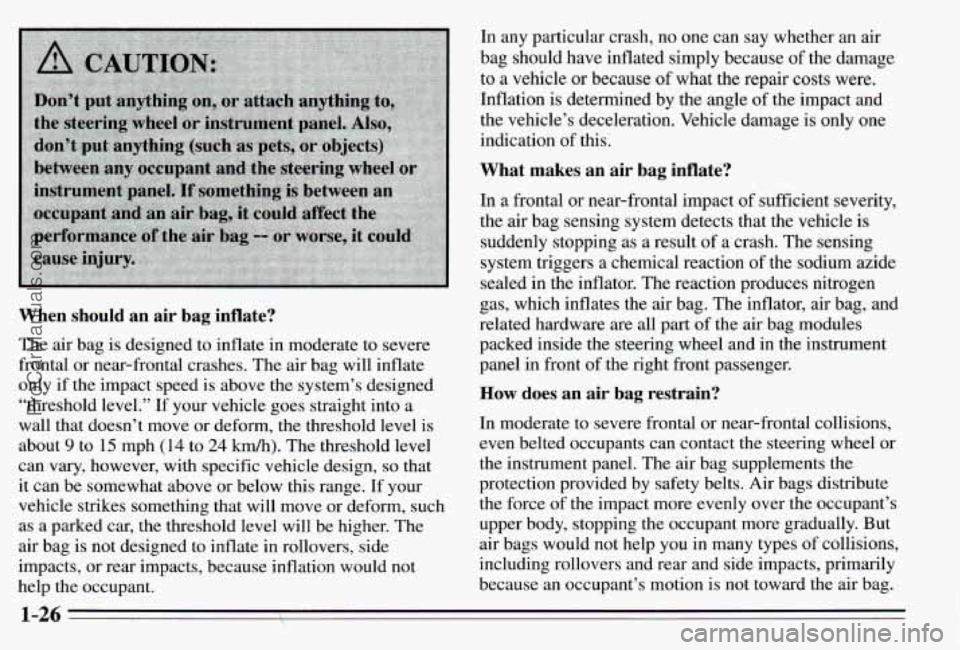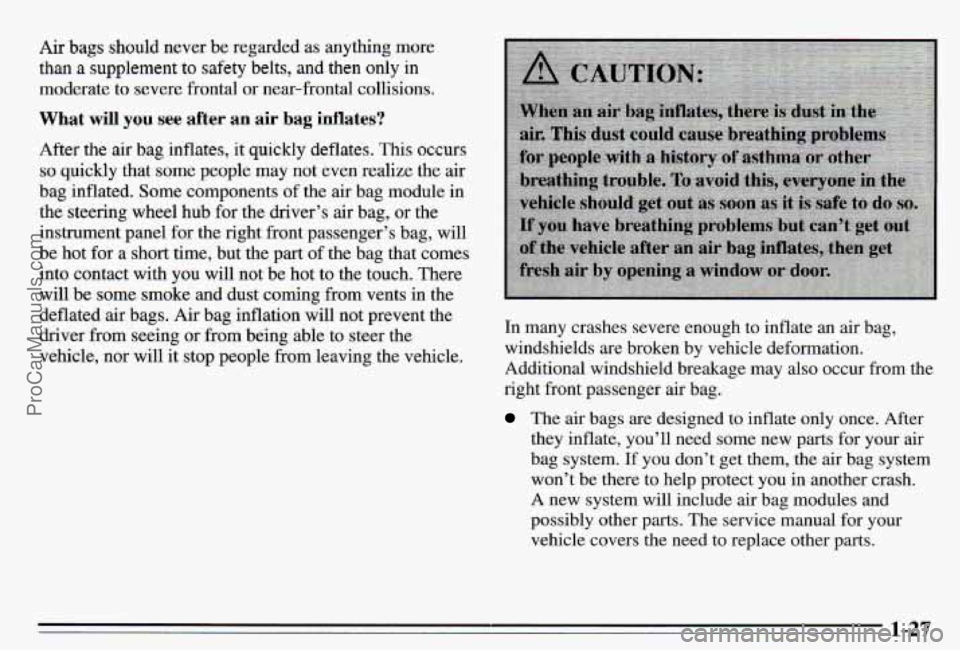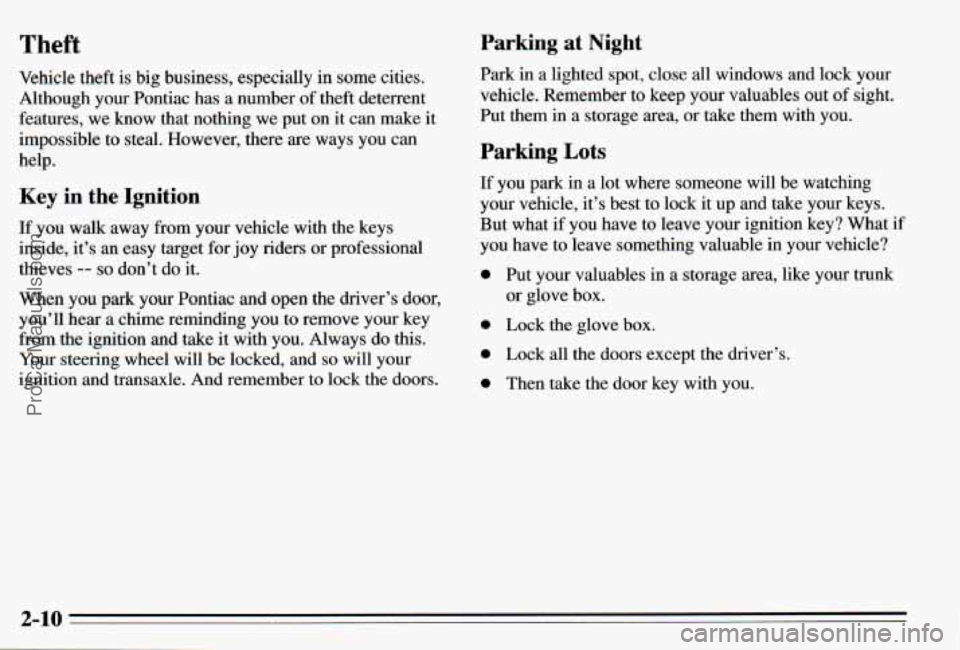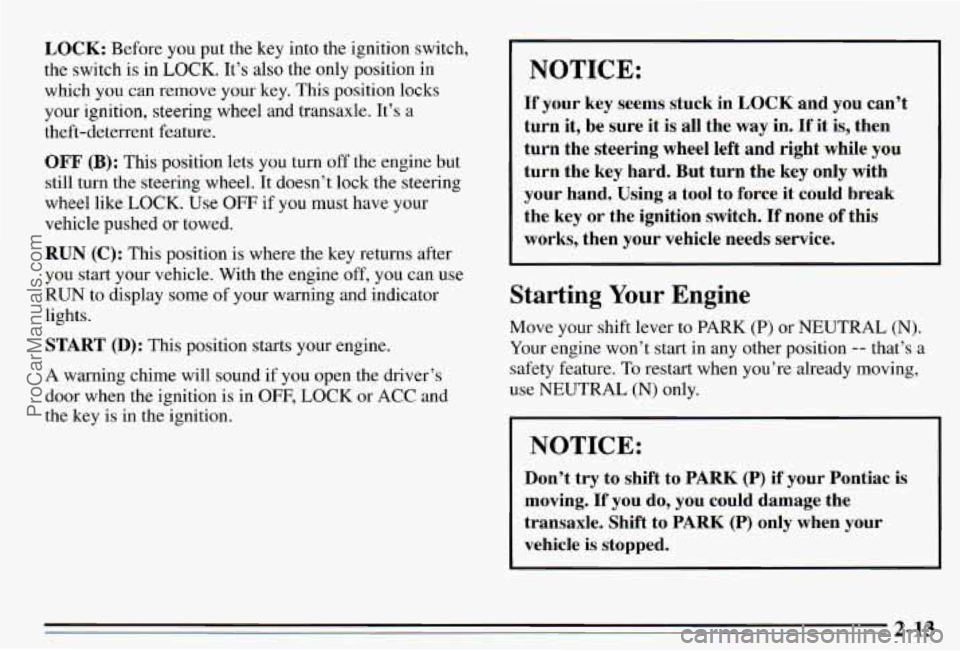Page 13 of 354
Why Safety Belts Work
When you ride in or on anything, you go as fast as it
goes.
Put someone on it.
Take the simplest vehicle. Suppose it’s just a seat on
wheels.
1-6
ProCarManuals.com
Page 32 of 354
How the Air Bag System Works
Where is the air bag?
The driver’s air bag is in the middle of the steering
wheel. The right front passenger’s air bag is
in the
instrument panel on the passenger’s side.
1-25
ProCarManuals.com
Page 33 of 354

When should an air bag inflate?
The air bag is designed to inflate in moderate to severe
frontal or near-frontal crashes. The air bag will inflate
only if the impact speed is above the system’s designed
“threshold level.”
If your vehicle goes straight into a
wall that doesn’t move or deform, the threshold level is
about
9 to 15 mph (14 to 24 lufl/h). The threshold level
can vary, however, with specific vehicle design,
so that
it can be somewhat above or below this range. If your
vehicle strikes something that will move or deform, such
as a parked car, the threshold level will be higher. The
air bag is not designed to inflate in rollovers, side
impacts, or rear impacts, because inflation would not
help the occupant. In any particular crash,
no one
can say whether an air
bag should have inflated simply because of the damage
to
a vehicle or because of what the repair costs were.
Inflation is determined by the angle of the impact and
the vehicle’s deceleration. Vehicle damage is only one
indication of this.
What makes an air bag inflate?
In a frontal or near-frontal impact of sufficient severity,
the air bag sensing system detects that the vehicle is
suddenly stopping as a result of a crash. The sensing
system triggers
a chemical reaction of the sodium azide
sealed in the inflator. The reaction produces nitrogen
gas, which inflates the air bag. The inflator,
air bag, and
related hardware
are all part of the air bag modules
packed inside the steering wheel and in the instrument
panel in front of the right front passenger.
How does an air bag restrain?
In moderate to severe frontal or near-frontal collisions,
even belted occupants can contact the steering wheel or
the instrument panel. The air bag supplements the
protection provided by safety belts. Air bags distribute
the force
of the impact more evenly over the occupant’s
upper body, stopping the occupant more gradually. But air bags would not help you in many types of collisions,
including rollovers and rear and side impacts, primarily
because an occupant’s motion
is not toward the air bag.
1-26 ,
ProCarManuals.com
Page 34 of 354

Air bags should never be regarded as anyhng more
than a supplement to safety belts, and then only in
moderate to severe frontal or near-frontal collisions.
What will you see after an air bag inflaters?
After the air bag inflates, it quickly deflates. This occurs
so quickly that some people may not even realize the air
bag inflated. Some components of the air bag module in
the steering wheel hub for the driver’s air bag, or the
instrument panel for the right front passenger’s bag, will
be hot for a short time, but the part
of the bag that comes
into contact with you will not be hot
to the touch. There
will be some smoke and dust coming from vents
in the
deflated
air bags. Air bag inflation will not prevent the
driver from seeing or from being able to steer the
vehicle, nor will it stop people from leaving the vehicle. In many crashes severe enough to inflate an air bag,
windshields are broken by vehicle deformation.
Additional windshield breakage may also occur fi-om the
right front pas.senges
air bag.
The air bags are designed to inflate only once. After
they inflate, you’ll need some new
parts for your air
bag system. If you don’t get them, the air bag system
won’t be there
to help protect you in another crash.
A new system will include air bag modules and
possibly other parts. The service manual for your
vehicle covers the need to replace other parts.
1 3’1
ProCarManuals.com
Page 35 of 354

Your vehicle is equipped with a alagnostic module,
which records information about the alia bag system,
The module records Mormation about the readiness
of the system, when the sensors are activated and
driver’s safety belt usage at deployment.
Let only qualified technicians work on your air bag
system. Improper service can mean that your air bag
system won’t work properly. See your dealer for
service.
NOTICE:
If you damage the cover for the driver’s or the
right front passenger’s
air bag, they may not
work properly. You may have to replace the air
bag module in the steering wheel or both the air
bag module and the instrument panel for the
right front passenger’s air bag.
Do not open or
break the
air bag covers.
Sewicing Your Air Bag-Equipped Pontiac
Air bags affect how your Pontiac should be serviced.
There
are parts of the air bag system in several places
around your vehicle. You don’t want the system to
inflate while someone
is working on your vehicle. Your
Pontiac dealer and the 1995 Grand Prix Service Manual
have information about servicing
your vehicle and the
air bag system.
To purchase a service manual, see
“Service Publications’’ in the Index.
The air bag system does not need regular maintenance.
1-28
ProCarManuals.com
Page 71 of 354

Theft Parking at Night
Vehicle theft is big business, especially in some cities.
Although your Pontiac has a number of theft deterrent
features, we know that nothing we put on it can make it
impossible to steal. However, there
are ways you can
help.
Key in the Ignition
If you walk away from your vehicle with the keys
inside, it’s
an easy target for joy riders or professional
thieves
-- so don’t do it.
When you park your Pontiac and open the driver’s door,
you’ll hear a chime reminding you to remove your key
from the ignition and take
it with you. Always do this.
Your steering wheel
will be locked, and so will your
ignition and transaxle. And remember to lock the doors. Park
in a lighted spot, close
all windows and lock your
vehicle. Remember to keep your valuables
out of sight.
Put them in a storage area, or take them with you.
Parking Lots
If you park in a lot where someone will be watching
your vehicle, it’s best to lock it up and take your
keys.
But what if you have to leave your ignition key? What if
you have to leave something valuable in your vehicle?
0 Put your valuables in a storage area, like your trunk
or glove box.
0 Lock the glove box.
0 Lock all the doors except the driver’s.
0 Then take the door key with you.
2-10
ProCarManuals.com
Page 73 of 354
New Vehicle “Break-In”
NOTICE:
Your modern Pontiac doesn’t need an elaborate
“break-in.” But it will perform better in the long
run if you follow these guidelines:
Don’t drive at any one speed -- fast or
slow
-- for the first 500 miles (804 km).
Don’t make full-throttle starts.
200 miles (322 km) or so. During this time
your new brake linings aren’t yet broken
in. Hard stops with new linings can mean
premature wear and earlier replacement.
Follow
this “breaking-in” guideline every
time you get new brake linings.
Don’t tow a trailer during “break-in.” See
“Towing
a ”railer’’ in the Index for more
information.
Avoid making hard stops for the first
Ignition Switch
With the ignition key in the ignition switch, you can turn
the switch to five positions:
ACC (A): This position lets you use things like the
radio and windshield wipers when the engine is
off. To
use ACC, push in the key and turn it toward you. Your
steering wheel will stay locked.
2-12
ProCarManuals.com
Page 74 of 354

LOCK: Before you put the key into the ignition switch,
the switch is in
LOCK. It’s also the only position in
which you can remove
your key. This position locks
your ignition, steering wheel and transaxle. It’s a
theft-deterrent feature.
OFF (B): This position lets you turn off the engine but
still turn the steering wheel. It doesn’t lock the steering
wheel like LOCK. Use
OFF if you must have your
vehicle pushed or towed.
RUN (C): This position is where the key returns after
you start your vehicle. With the engine
off, you can use
RUN to display some of your warning and indicator
lights.
START
(D): This position starts your engine.
A warning chime will sound if you open the driver’s
door when the ignition is in
OFF, LOCK or ACC and
the key is in the ignition.
NOTICE:
If your key seems stuck in LOCK and you can’t
turn it, be sure it is all the way in.
If it is, then
turn the steering wheel left and right while you
turn the key hard. But turn the key only with
your hand. Using
a tool to force it could break
the key or the ignition switch.
If none of this
works, then your vehicle needs service.
Starting Your Engine
Move your shift lever to PARK (P) or NEUTRAL (N).
Your engine won’t start in any other position
-- that’s a
safety feature. To restart when you’re already moving,
use NEUTRAL (N) only.
NOTICE:
Don’t try to shift to PARK (P) if your Pontiac is
moving.
If you do, you could damage the
transaxle. Shift to PARK
(P) only when your
vehicle is stopped.
2-13
ProCarManuals.com